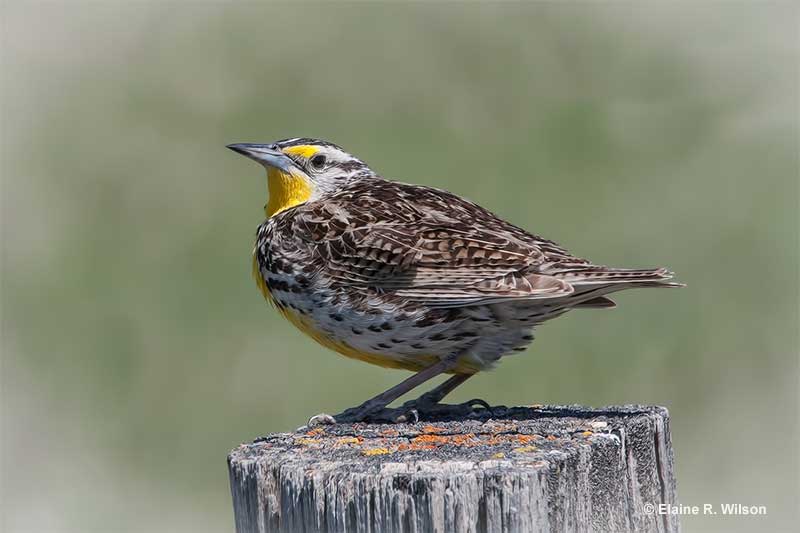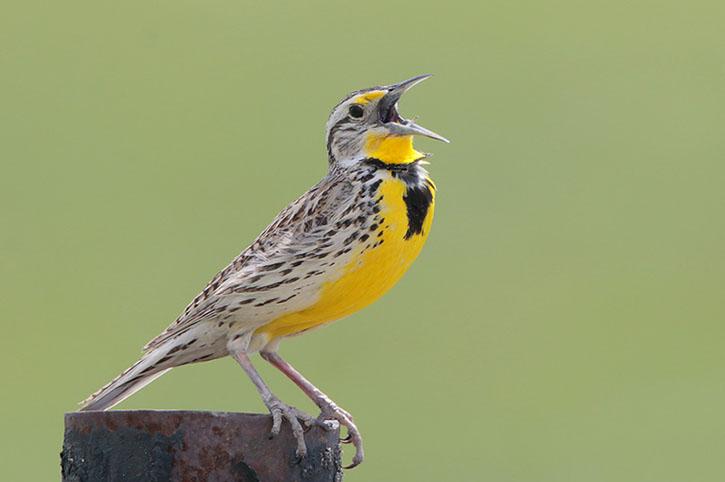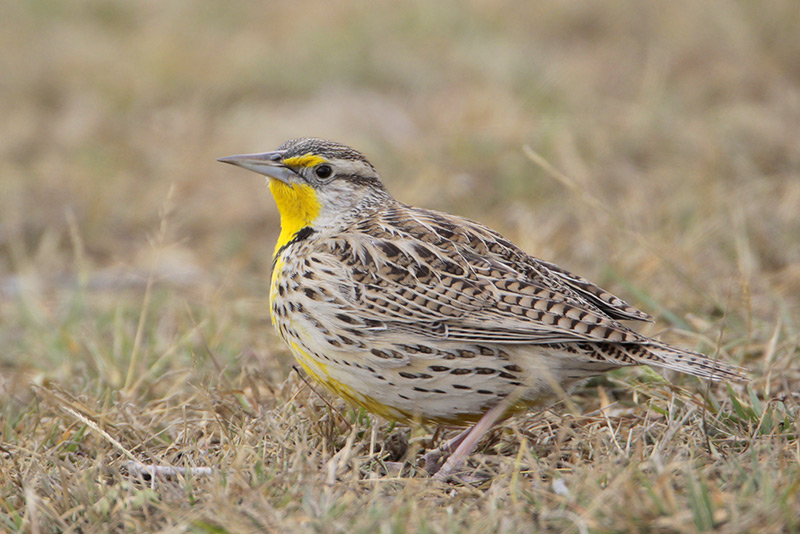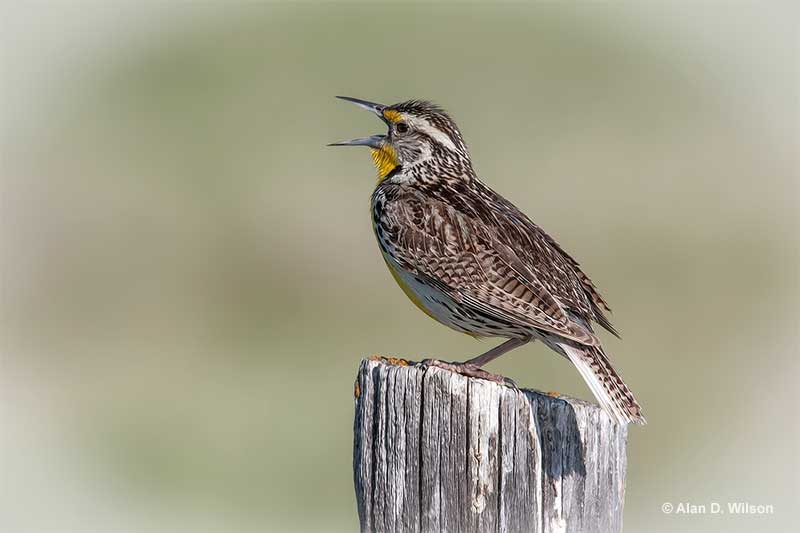
Montana is a huge state with 147,040 square miles of grasslands, wild, scenic mountains, wetlands, and other habitats. 1,1 million people live in the towns, farms, and wide-open spaces of the Big Sky Country.
Montana state bird is a pale brown and yellow blackbird species with a black “V” mark on its chest and a pleasant voice. This pretty bird is a common sight in open habitats throughout Montana.
With so much wild habitat, it’s no wonder Montana has a bird list of 445 species! One of those beautiful birds is the Western Meadowlark.
On this page
State Bird
The Western Meadowlark became the official state bird of Montana on March 14, 1931. This was the date when the state legislature voted to make this species an official state symbol. However, they didn’t make that decision on their own.
In the late 1920s, the General Federation of Women’s Clubs were encouraging states across the nation to pick an official state bird.
They often worked with local Audubon clubs and organized votes where local schoolchildren would pick the state bird. In Montana, grade-schoolers ended up choosing the Western Meadowlark, the state legislature agreed with this choice and voted to make it official.

This species was an easy choice for the folks of Montana because it is a common, easily seen bird throughout the state.
The beautiful song of the Western Meadowlark is also an essential piece of the state’s wide-open landscapes.
The schoolchildren who voted for this species undoubtedly heard and saw this brightly-colored common bird on their farms, walks to school, and in their neighborhoods. The bird played a regular role in their daily lives but it was also appreciated on the farm. Unlike species that eat grain, the Western Meadowlark helps farmers by feasting on grasshoppers and other pests.
Fun Facts about Western Meadowlarks
- Western Meadowlarks help farmers by eating grasshoppers and other insects that damage crops. At first, farmers were worried this species might be a threat. However, studies in 1914 demonstrated that instead of eating grain, the Western Meadowlark eliminated insect pests.
- This species was formerly considered the same as the very similar Eastern Meadowlark. However, in 1844, John James Audubon wrote a publication mentioning the differences in songs and habitats between meadowlarks. He suggested that the bird be known as “Sturnella neglecta”. Eventually, further studies showed that Eastern and Western Meadowlarks only occasionally hybridized and were indeed separate species.
- Despite its name, the Western Meadowlark and other meadowlark species are not in the lark family. They were partly named after larks because, like those birds, meadowlarks often sing and live in open spaces. However, they are actually members of the blackbird family and more related to Red-winged Blackbirds and grackles!
- This species makes a hidden nest on the ground with a domed cover and an entrance tunnel that can be several feet long!
- In common with most blackbird species, Western Meadowlarks can stick their strong, sharp beak into the ground or vegetation, and open it to make a hole. This helps them find insects and grubs hidden in the soil.
- Western Meadowlark is the state bird of Kansas, Nebraska, Oregon, North Dakota, and Wyoming too!
Identification
The Western Meadowlark is a rotund bird a bit bigger than a European Starling and around the same size as a Northern Mockingbird. It is 9.5 inches long, has a wingspan of 14.5 inches, and weighs 3.4 ounces.
This species is a pale brown and yellow bird with a prominent black “V” mark on its chest. It has yellow on its throat, in front of its eyes, and on much of its underparts. They also have a little bit of yellow on the lower part of their face; this is one of the field marks to help separate it from the similar Eastern Meadowlark.

Western Meadowlarks have pale brown mottling and streaks on their backs and wings, and white sides with small black markings. They have a finely streaked, dark crown, a grayish-white face, and a thick black line going back from their eyes.
Both sexes look the same but males are slightly bigger than females and also have brighter plumage. Winter birds and immatures have paler plumage and the black markings on their chest, face, and underparts aren’t as bold.
The Western Meadowlark walks on long, pink-gray legs, and flutters and glides on rounded wings. In flight, the white in its rounded tail becomes an obvious field mark.
Related: Birds of Montana (34 Most Popular)
What do Western Meadowlarks eat?
Western Meadowlarks feed on a variety of insects and seeds. They eat many grasshoppers, beetles, crickets, ants, and most other insects they manage to find.
This species forages for arthropods by walking through open habitats with short grass and keeping an eye out for prey. They have a preference for barren spots and other open areas with little vegetation.
When this bird sees an insect, it quickly snatches the creature with its beak. To find insects that might be hiding in the grass or underground, the Western Meadowlark also pokes its beak into the soil and grass stalks. After poking its beak into a spot, the bird opens its bill to move the soil or vegetation, and reveal any hidden insects.
Western Meadowlarks also pick up small seeds from “weedy plants” but more so in the winter months. On occasion, these adaptable birds can also prey on the eggs and nestlings of other bird species. In winter, they have even been seen picking at dead animals!
Call
The Western Meadowlark is a very vocal bird species. Its easily recognized song is a brief, melodious phrase of flute-like whistles, “rip TEE-tur, ripadip”. Males often sing and can do so all year long but sing most often during the spring and summer months.
They can sing while standing on the ground but usually sing from the top of a fence post, rock, or other slightly elevated perch.
This species also makes other brief calls and a distinctive rattle-sounding vocalization. When the Western Meadowlark sees a predator or is alarmed by someone walking too close to its nest, it makes a loud, abrupt, “chup!” call.

Behavior
The Western Meadowlark is usually seen standing or steadily walking on the ground through open habitats with sparse vegetation. It spends a lot of time walking and foraging, and can be alone or near its mate.
After breeding and in the winter months, Western Meadowlarks tend to form small flocks that feed in the same field. However, they still keep some distance from each other.
We can see these birds in farm fields, pastures, shortgrass prairies, and other wide-open habitats.
Male Western Meadowlarks are often seen singing. They like to sing from a low perch but can also do so while standing on the ground. This species tends to fly low, a bit like a quail. They often chase each other in flight.
The Western Meadowlark can be aggressive to other meadowlarks in its territory and can attack the nests of smaller birds, but it does not threaten pets or people. Various predators eat this species, including snakes, foxes, owls, falcons, and hawks.
Which Birds Can You See In Montana?
Montana is known for its vast birding scene – there are owls, hawks, woodpeckers, and many common duck species. Here are some of the most common birds of the state:
- Black-billed Magpie
- Black-capped Chickadee
- Northern Flicker
- American Robin
- Common Raven
- Mallard
- Canada Goose
See more: Birds of Montana
Montana State Bird: Frequently Asked Questions
How many bird species are in Montana?
In total, 445 bird species are in Montana. This is the number of species on the official Montana bird list.
What is the rarest bird in Montana?
The rarest bird in Montana is the Whooping Crane. Small numbers of this endangered species migrate through parts of eastern Montana.
What birds is Montana known for?
Montana is known for grassland and mountain birds. This state is a good place to see the uncommon Sprague’s Pipit, longspurs, Golden Eagles, and many other species of wild habitats.

